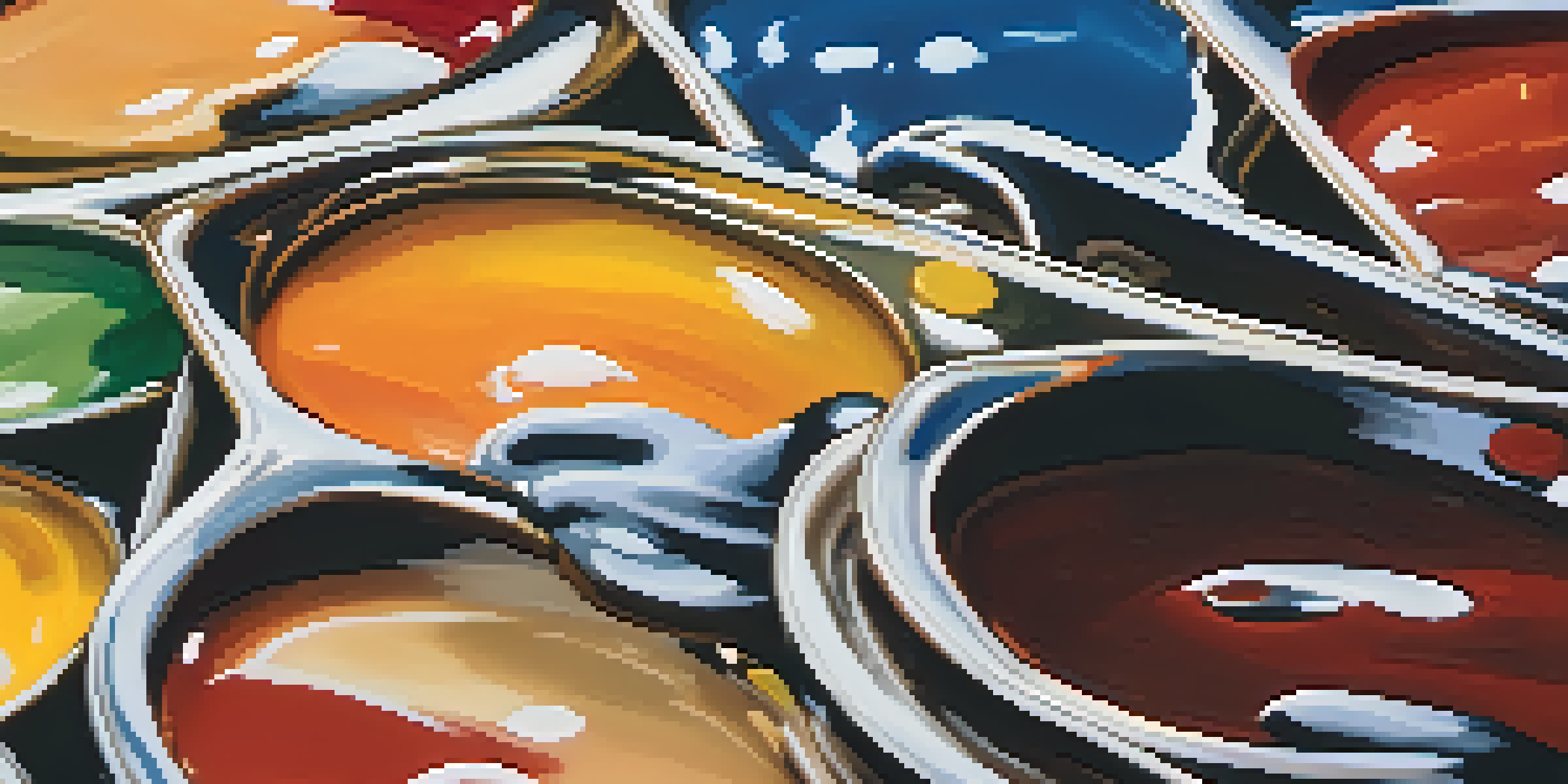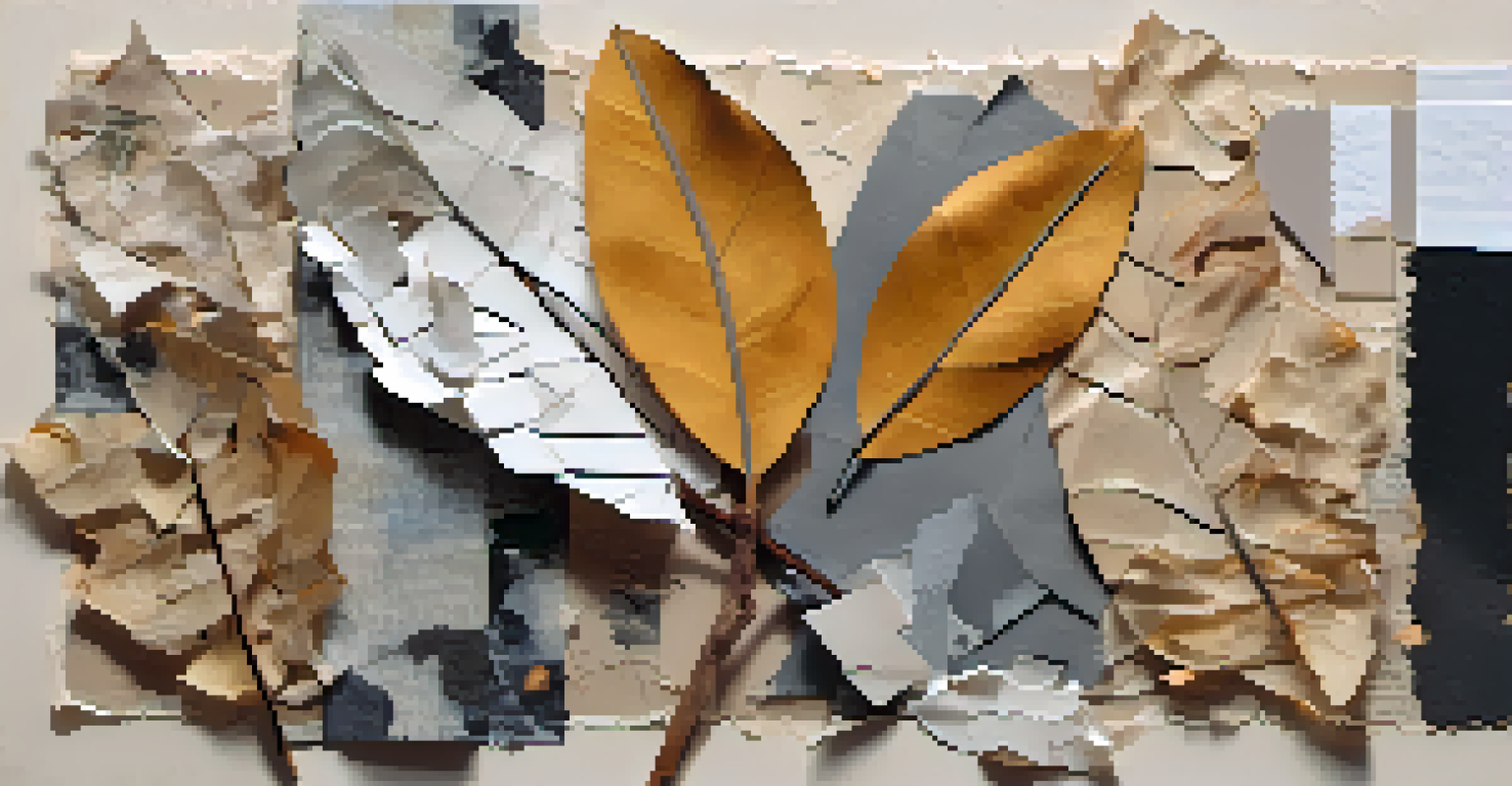Creating Textured Surfaces in Art: Techniques and Materials

Understanding Texture in Art and Its Importance
Texture is a vital element in art, adding depth and interest to a piece. It can evoke emotions and draw viewers in, making them want to explore the artwork further. Think of texture as the tactile quality that influences how we perceive a piece, even before we touch it.
Texture is the mother of all art.
Incorporating texture can transform a flat canvas into a vibrant, dynamic experience. Whether it’s the roughness of a stone or the smoothness of glass, each texture tells its own story. Artists often use texture to convey feelings or themes, enhancing the overall impact of their work.
By understanding and utilizing texture, artists can elevate their creations. This not only engages the viewer’s senses but also invites them to connect with the art on a deeper level. The journey into textured surfaces is a thrilling adventure that begins with an appreciation for the art form itself.
Choosing the Right Materials for Texture
Selecting the right materials is crucial for achieving the desired texture in art. Common materials include acrylics, oils, and mixed media, each offering unique textural possibilities. For instance, acrylics can be thickened with gels, while oils can be layered for a smoother appearance.

Natural materials like sand, fabric, and paper can also be incorporated to create interesting surfaces. Using these items can add an organic feel to the artwork, inviting tactile exploration. This approach allows artists to step beyond traditional mediums and experiment with diverse textures.
Importance of Texture in Art
Texture adds depth and emotional engagement, transforming a simple piece into a dynamic experience.
Ultimately, the choice of materials should reflect the artist's intent and vision. By thoughtfully selecting materials, artists can enhance the textural quality of their work, creating a more engaging experience for viewers. The right materials can make all the difference in bringing a vision to life.
Techniques for Creating Texture with Paint
There are numerous techniques artists can employ to create texture using paint. One popular method is impasto, where paint is applied thickly to the canvas, creating a three-dimensional effect. This technique can give the artwork a lively and expressive quality, drawing the viewer’s eye.
Art is not what you see, but what you make others see.
Another technique is sgraffito, which involves scratching through a layer of paint to reveal the surface underneath. This can produce intricate patterns and designs, adding a layer of complexity to the artwork. Think of it as revealing hidden treasures within the layers of paint.
Layering is also an effective technique, where multiple coats of paint are applied to build texture gradually. By varying application methods—like brushing, sponging, or even pouring—artists can achieve unique effects that enhance the overall visual experience. Each technique invites exploration and experimentation.
Incorporating Collage for Added Dimension
Collage is a fantastic way to introduce texture into artwork, combining different materials and mediums. By layering paper, fabric, or other found objects, artists can create a rich tapestry of textures. This method not only adds depth but also tells a story through the variety of elements used.
The beauty of collage is its versatility; it can be as simple or complex as the artist desires. For instance, using torn magazine pages can add a delicate, fragmented texture, while fabric pieces can impart warmth and richness. Each addition contributes to the overall narrative of the artwork.
Materials Enhance Textural Quality
Choosing the right materials, like acrylics or found objects, allows artists to create unique textures that reflect their vision.
Collage also allows for spontaneity, encouraging artists to experiment without the constraints of traditional painting. This freedom can lead to unexpected discoveries and innovative textures. Embracing collage opens up a world of creative possibilities, inviting artists to think outside the box.
Texturing with Found Objects and Mixed Media
Using found objects is an exciting way to create texture in art, as it brings an element of surprise. Everyday items like leaves, buttons, or even scraps of metal can be transformed into artistic treasures. By integrating these materials, artists can add a personal touch and a story to their work.
Mixed media techniques further enhance textural possibilities, allowing the combination of various materials and methods. For instance, combining paint with clay or plaster can yield stunning results. Each layer contributes its own unique texture, creating a multifaceted experience for the viewer.
Exploring found objects and mixed media challenges traditional boundaries in art. It encourages artists to look at the world differently, seeing potential in the simplest items. This approach not only enriches the artwork but also fosters a deeper connection between the artist and their surroundings.
Experimenting with Texture through Other Mediums
While paint is a popular choice for creating texture, other mediums can be just as effective. For instance, sculpture offers endless opportunities for textural exploration. Artists can manipulate materials like clay, wood, or metal to create tactile surfaces that invite interaction.
Textile art is another avenue where texture plays a crucial role. Techniques like weaving, stitching, and felting can produce stunning textural effects. Each stitch or weave adds depth, transforming fabric into a remarkable piece of art.
Techniques for Textured Expression
Various painting techniques, such as impasto and collage, enable artists to explore and innovate with texture in their work.
By venturing into different mediums, artists can discover new ways to express texture. This exploration fosters creativity and can lead to innovative ideas that challenge traditional notions of art. Embracing various mediums enriches the artist's toolkit, paving the way for exciting discoveries.
Final Thoughts on Textured Surfaces in Art
Creating textured surfaces in art is a rewarding journey that enhances the viewer's experience. By understanding and experimenting with different techniques and materials, artists can find unique ways to express themselves. Each textured element adds another layer of meaning to the artwork.
As you explore texture, remember that there are no strict rules—only opportunities for creativity. Embrace the process, and allow yourself to play with different textures, materials, and techniques. This exploration can lead to unexpected outcomes that may surprise and delight you.

Ultimately, textured surfaces invite viewers to engage with art on a deeper level. They encourage touch, curiosity, and emotional connection. So, gather your materials, unleash your creativity, and let the world of texture inspire your next artistic endeavor.